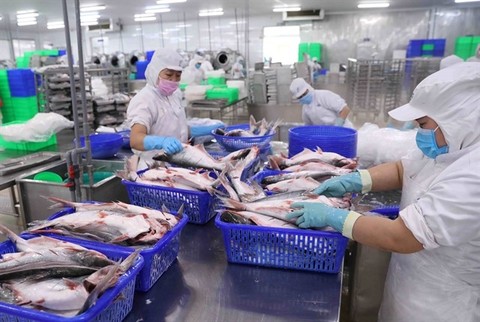
Pangasius exports in the first eight months of this year increased by 9 per cent on year to $1.3 billion. —VNA/VNS Photo
Việt Nam saw a gradual recovery of seafood exports during the first eight months of this year, both in terms of demand and price.
According to the Việt Nam Association of Seafood Exporters and Producers (VASEP), the value of seafood exports in the first eight months reached nearly US$6.3 billion, up nearly nine per cent over the same period last year.
In August alone, this value reached a growth rate of 20 per cent to nearly $953 million.
VASEP reported that, apart from squid and octopus, whose export turnover decreased by 15 per cent in August, the exports of all other key products had double—or triple-digit growth. Shrimp exports rose by 30 per cent, pangasius by 18 per cent, tuna by 13 per cent, and other marine fish by 12 per cent.
During the first eight months, shrimp exports reached $2.4 billion, up nine per cent year over year, including $1.75 billion from white-leg shrimp and $290 million from black tiger shrimp.
Lobster alone maintained good growth momentum in August, so the lobster export turnover in the first eight months was 140 per cent higher than the same period in 2023.
VASEP said that shrimp exports are showing a positive trend, with stable growth in recent months, though they are facing challenges from anti-subsidy and anti-dumping taxes.
Shrimp consumption has begun to increase in Europe and the US, which is a positive sign for the market, although the price of shrimp exported to China is still low.
Pangasius exports in the first eight months increased by nine per cent on year to $1.3 billion. Exports to China remained stagnant, but the recovery of the US market was a lever for pangasius exports to grow. The exports to the US surged by 23 per cent over the same period last year, while the exports to China decreased by three per cent.
Việt Nam also saw a growth of 21 per cent on year in tuna exports during the first eight months to $652 million.
However, VASEP believes that in the coming months, the tuna export market may find it difficult to maintain this growth momentum due to a lack of raw materials.
With Decree 37/2024/NĐ-CP, effective from May 19, 2024, which requires the size for skipjack tuna to be at least half a metre, companies have been almost unable to buy enough domestic raw material of tuna to produce canned tuna, as well as other export products from tuna.
Squid and octopus exports have been most affected by the IUU yellow card. The issue of certifying the exploitation of this product has encountered many difficulties, causing the enterprises to not have eligible raw materials for processing export products. Therefore, squid and octopus exports in the first eight months fell by two per cent compared to the same period last year to $402 million.
The association expects that seafood exports for this whole year will be at $9.4-9.5 billion, up six per cent compared to 2023, because there are still some major challenges curbing the export growth in the remaining months, such as the IUU yellow card, anti-subsidy tax and anti-dumping tax. — VNS